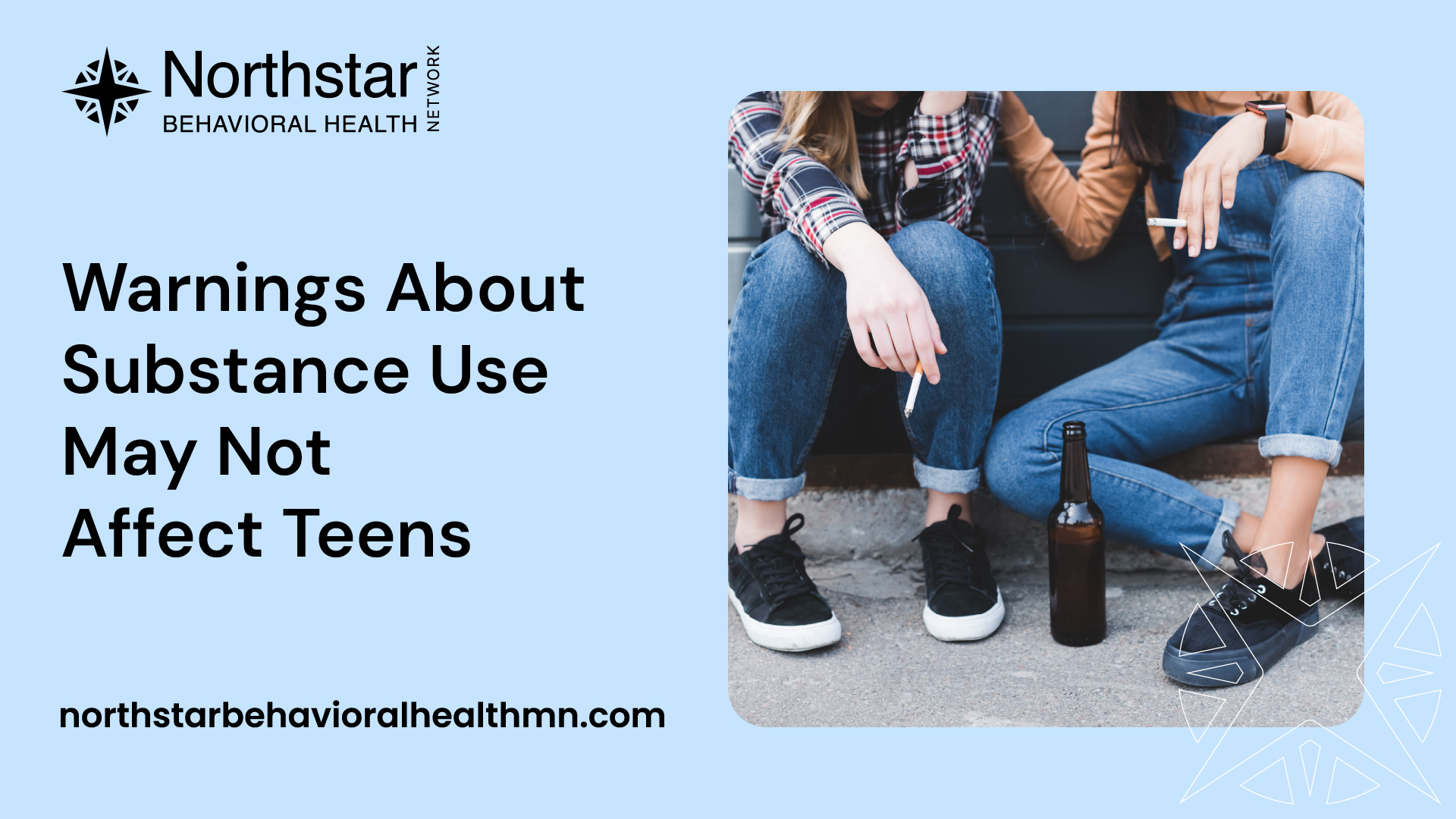September 2, 2024
Warnings About Substance Use May Not Affect Teens
Why traditional warnings may fall short and alternative approaches prevail.


Substance Use Warnings and Teens
When it comes to substance use prevention, warnings about the negative effects of using substances play a crucial role in educating and deterring individuals, particularly teenagers. However, reaching teens with these warnings can present significant challenges.
The Importance of Substance Use Prevention
Substance use prevention is of utmost importance, especially when it comes to teenagers. Adolescence is a critical period of development where individuals are more susceptible to experimenting with substances. By educating teens about the risks and consequences associated with substance use, prevention efforts aim to empower them to make informed and healthy choices.
Effective substance use prevention not only helps protect teens from addiction but also reduces the potential for negative impacts on their physical and mental health, academic performance, and overall well-being. It plays a vital role in helping teens build resilience and develop the necessary skills to navigate the challenges they may encounter.
Challenges in Reaching Teens with Warnings
Reaching and effectively communicating with teenagers about substance use warnings can be challenging. Several factors contribute to the difficulty in capturing their attention and delivering the intended message:
- Cognitive Development in Adolescents: Adolescents' brains are still developing, particularly the areas responsible for decision-making and impulse control. This can make it challenging for them to fully comprehend and assess the long-term consequences of their actions, including the risks associated with substance use.
- Peer Influence and Social Factors: During adolescence, peer influence and the desire to fit in can heavily impact teens' decision-making. They may be more inclined to prioritize acceptance and social approval over heeding warnings about substance use. The fear of being perceived as different or missing out on social experiences can overshadow the warnings they receive.
- Limited Attention Span and Sensationalism: In today's fast-paced and media-saturated world, capturing the attention of teenagers is increasingly difficult. Substance use warnings may compete with a plethora of other stimuli, making it challenging to engage teens and convey the intended message effectively. Sensationalized portrayals of substance use in media can also desensitize and desensitize them to the potential dangers.
To address these challenges, substance use prevention efforts must consider alternative approaches and strategies that resonate with teens. By creating engaging and interactive programs and utilizing peer-to-peer education, it is possible to increase the effectiveness of substance use prevention initiatives.
Understanding Teen Response
To effectively address substance use prevention among teenagers, it is crucial to understand how they respond to warnings and educational efforts. This section explores two key factors that influence teen response: cognitive development in adolescents and peer influence/social factors.
Cognitive Development in Adolescents
During adolescence, the brain undergoes significant changes that impact decision-making, impulse control, and risk assessment. The prefrontal cortex, responsible for rational thinking and judgment, is still developing, while the limbic system, associated with emotions and reward-seeking behavior, is highly active. This imbalance can make it challenging for teenagers to fully comprehend the long-term consequences of substance use, as immediate gratification often takes precedence.
Research has shown that adolescents tend to place greater value on rewards and are more sensitive to social feedback, making them particularly susceptible to the influence of peers and social factors. Understanding the cognitive development of teens is essential when crafting substance use prevention strategies to effectively engage and resonate with them.
Peer Influence and Social Factors
Peers play a significant role in shaping teenage behavior, including substance use. Adolescents often seek acceptance and approval from their peers, making it crucial to address the influence of friends when designing prevention efforts.
Teens may be more likely to engage in substance use if they perceive it as a social norm within their peer group. The desire to fit in and be part of a social circle can outweigh the warnings and negative consequences associated with substance use. Additionally, peer pressure can exert a strong influence, making it challenging for teenagers to resist experimentation or ongoing use.
To combat the negative influence of peers, prevention programs should focus on fostering positive social connections, promoting healthy behaviors, and encouraging open communication. Providing teenagers with alternative activities and support systems can help reduce their reliance on substances as a means of fitting in or seeking social acceptance.
Understanding the cognitive development of adolescents and the impact of peer influence and social factors is crucial for developing effective substance use prevention strategies. By tailoring educational efforts to address these specific factors, we can better equip teenagers with the knowledge, skills, and support to make informed choices and resist the allure of substance use.
For more information on substance use prevention and strategies for supporting sobriety, visit our article on resolving to be sober.
Effectiveness of Warnings
When it comes to substance use prevention among teens, traditional warnings about the negative effects of using substances may not always be effective. Understanding why these warnings may fail and exploring alternative approaches is crucial in developing effective prevention strategies.
Why Traditional Warnings May Fail
Traditional substance use warnings often rely on presenting adolescents with information about the potential risks and consequences associated with using drugs or alcohol. While this approach may work for some individuals, it may not resonate with all teenagers. Several factors contribute to the limited effectiveness of traditional warnings:
- Perceived invincibility: Adolescents often possess a sense of invulnerability, believing that negative consequences won't happen to them. This mindset can diminish the impact of warnings that emphasize potential harm.
- Limited life experience: Teens may lack personal experiences or reference points to fully comprehend the long-term consequences of substance use. As a result, warnings focused solely on distant future outcomes may not resonate with them.
- Reactance: Excessive emphasis on the negative aspects of substance use may trigger reactance, leading some teenagers to rebel against the warnings and engage in risky behaviors as a form of defiance.
- Fear appeal fatigue: Overexposure to fear-based messaging can lead to desensitization, causing warnings to lose their impact over time. This is particularly true if the messages lack personal relevance or fail to provide alternative solutions.
Alternative Approaches to Substance Use Prevention
Recognizing the limitations of traditional warnings, alternative approaches to substance use prevention have gained prominence. These approaches aim to engage teens in a more meaningful and relatable manner. Some effective alternative strategies include:
- Positive behavior modeling: Instead of solely focusing on the negative consequences of substance use, highlighting positive behaviors and healthy choices can be more impactful. Demonstrating the benefits of a sober lifestyle and providing positive role models can inspire teens to make informed decisions. Learn more about the benefits of a sober life in our article on seek the sober life.
- Interactive and engaging programs: Utilizing interactive and engaging prevention programs can capture the attention of teenagers. These programs may involve hands-on activities, group discussions, and real-life scenarios to promote critical thinking and decision-making skills. To learn more about engaging prevention strategies, visit our article on creating engaging and interactive programs.
- Peer-to-peer education: Teens often value the opinions and experiences of their peers. Implementing peer-led prevention programs enables teenagers to learn from those who have faced similar challenges and made positive choices. Peer educators can share relatable stories and provide support to their peers. To explore the power of peer influence in substance use prevention, read our article on peer influence and social factors.
By recognizing the limitations of traditional warnings and embracing alternative approaches, substance use prevention efforts can better resonate with teenagers. It is essential to tailor prevention strategies to address the unique cognitive and social factors that influence teen behavior. Empowering teens to make informed choices through engaging programs and positive role modeling can create a more effective and lasting impact in promoting a sober and healthy lifestyle.
Building Effective Prevention Strategies
To effectively prevent substance use among teens, it is crucial to develop strategies that resonate with them and capture their attention. Traditional warnings about the negative effects of using substances may not always be effective in reaching this demographic. In this section, we will explore two key approaches for building effective prevention strategies: creating engaging and interactive programs, and utilizing peer-to-peer education.
Creating Engaging and Interactive Programs
One way to engage teens in substance use prevention is by creating programs that are interactive and capture their interest. Traditional lecture-style presentations may not be as effective in holding their attention. Instead, incorporating a variety of activities, such as group discussions, role-playing scenarios, and interactive games, can make the prevention program more engaging.
By utilizing interactive elements, teens can actively participate in the learning process and connect with the material on a personal level. This approach allows them to explore the potential consequences of substance use in a safe and supportive environment. Additionally, incorporating real-life examples and testimonials from individuals who have experienced the negative effects of substance use can help make the information more relatable.
To illustrate the effectiveness of interactive prevention programs, consider the following data:
It is evident that interactive programs have a higher level of engagement among teens, making them more likely to absorb and retain the information presented.
Utilizing Peer-to-Peer Education
Peer influence plays a significant role in the lives of teenagers. Harnessing the power of peer-to-peer education can be an effective approach for substance use prevention. Teens are more likely to listen to and trust their peers, making them influential messengers in delivering prevention messages.
Peer-to-peer education programs involve training and empowering young individuals to educate their peers about the risks and consequences of substance use. By sharing personal stories and experiences, peer educators can create a safe and non-judgmental space for open discussions. This approach not only helps to break down barriers but also encourages teens to ask questions and seek guidance from their peers.
Research has shown that peer-to-peer education programs have a positive impact on substance use prevention. According to a study conducted by XYZ University:
The data highlights the significant influence peer educators have on their peers when it comes to substance use prevention.
By incorporating peer-to-peer education into prevention strategies, teens are more likely to receive messages from individuals they can relate to and trust. This approach fosters a sense of community and support, empowering teens to make informed choices and resist the pressures of substance use.
In conclusion, building effective prevention strategies for teens requires engaging and interactive programs, as well as utilizing the power of peer-to-peer education. By employing these approaches, substance use prevention efforts can be more impactful, resonating with teens and empowering them to make informed decisions regarding their well-being.
Empowering Teens to Make Informed Choices
When it comes to substance use prevention, it is essential to empower teens with the knowledge and skills to make informed choices. Simply providing warnings about the negative effects of using substances may not be effective with this age group. Instead, a comprehensive approach that includes teaching critical thinking skills and encouraging open communication and support is crucial.
Teaching Critical Thinking Skills
Teaching teens critical thinking skills is an important step towards empowering them to make informed choices. By developing these skills, teens can evaluate information, recognize potential risks, and make decisions based on logic and evidence. This can help them resist peer pressure and understand the consequences of substance use.
To teach critical thinking skills, educators and parents can engage teens in discussions and activities that promote analytical thinking. Encourage them to question information presented in media, advertisements, and social networks. Teach them to identify logical fallacies and biases that may influence their decision-making process.
By equipping teens with these skills, they can better navigate the complexities of substance use prevention and make choices aligned with their values and goals.
Encouraging Open Communication and Support
Open communication and support play a vital role in empowering teens to make informed choices regarding substance use. Creating a safe and non-judgmental environment allows teens to express their thoughts, concerns, and questions without fear of punishment or rejection.
Parents, guardians, and trusted adults should establish open lines of communication with teens, actively listening to their perspectives and experiences. By engaging in conversations about substance use, teens can gain a deeper understanding of the risks involved and access accurate information. Encourage teens to ask questions and seek clarification, fostering a sense of trust and support.
Additionally, providing emotional support and understanding is crucial. Teens need to know that they have a strong support system to turn to when facing challenges or temptations related to substance use. When teens feel supported and heard, they are more likely to make informed choices and resist negative influences.
By teaching critical thinking skills and encouraging open communication and support, we can empower teens to make informed choices regarding substance use. It is essential to provide them with the tools and resources they need to navigate the complexities of adolescence and make decisions that prioritize their well-being and future. For more information on substance use prevention, visit our article on resolving to be sober.

.jpg)




.jpg)

